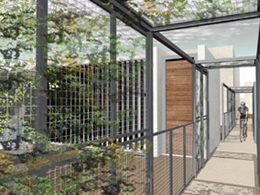STUDENTS PROJECTS
PROJECTS2013

02 March, 2014
Reuse of existing dwelling infrastructure
Adjustment of the existing dwelling infrastructures. Typology in the contemporary social life.
Student: Protou Maria
Supervisor: Philokyprou Maria
Educational Institution: University of Cyprus, Department of Architecture
Presentation Date: 18/5/2013
This diploma thesis deals with the issue of reusing existing infrastructures. Its specific purpose is to examine how the typology of the existing dwelling infrastructures can accommodate and serve the contemporary way of living. How some specific social conditions developed certain dwelling infrastructures and how they can be used today? Both analysis and proposal are concerned on a part of the Limassol old town. An area, mainly residential, where nowadays, a discontinuity in the habitation and degradation is observed. (Abandonment of traditional buildings and continuous addition of new uses)
The initial theoretical analysis focuses on the related concepts of rehabilitation, reuse, conservation, protection and inclusion and typology. In particular the reasons for rehabilitation and reuse of existing infrastructures are being investigated, as well as the ways of how to reuse existing infrastructures and the ways that the typological characteristics of the residential units have been developed.
Thereafter, the housing typology of the area and the surrounding area is being analyzed. It is important to consider the adjacent areas, both in analysis and in the decision making part, as an action in a given area will affect its adjacent area or even adjacent areas can affect the actions in the area of intervention. Additionally, contemporary housing examples in Cyprus are being analyzed in order to be compared with the traditional production process and the way the spaces are being used. Also, housing examples from abroad are being analyzed.



Eventually, the design intent is to subvert the discontinuity in the habitation and degradation that is being observed in the region. This suggestion is made in two levels. As regards the housing units, ways on how an existing space that occurred to meet the physical needs (traditional architecture) can be adjusted so, that it covers the activities that can happen in a space (modern architecture) are being suggested. For this reason functional-spatial reorganizations that have to do with the contemporary way of life, and embody concepts like adaptability and multifunctionality that are considered as very important are being proposed. There are also suggestions about the improvement of the surrounding environment. At the scale of the neighborhood, the creation of public spaces and facilities that operate to support the housing use and that are suitable for collective uses by each user are being proposed. In a smaller scale ways about redefining the relations and the limits between the housing units are being suggested. Significant at both levels (neighborhood scale and housing units) is considered the reset of the cultivation uses. Reset, since, as it will be discussed later, the area morphology is being associated with the way that the land was cut in order to provide the suitable space for residential development which was associated with an earlier dissection to create farmland. Cultivation is proposed in collective level in empty plots that are temporarily not in use, individually at housing units. Beyond the association of cultivation with the previous use, it will enrich the environment of the region and offer new incentives of living to the users.
More specifically, for the housing units, the proposal is about the retention of existing users, while through the general plan, it is expected to attract new users. Due to the proximity of the area to the Technological University of Cyprus and uses that have to do with tourism, is being suggested the accommodation of students and 'urban' tourists in a circular rate from the permanent residents. Thus it is suggested a kind of cohabitation in each piece. Thereby, it is given the opportunity for interaction between different users with different benefit for each one. The design questions that arise from such an intention and for which are given solutions, are how the house responds to each user and how each of them can claim and shape-define its own space in the whole house.

















